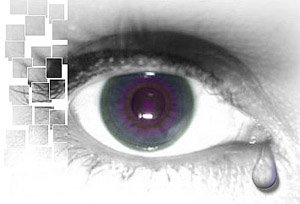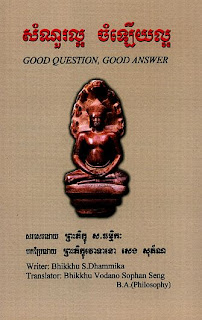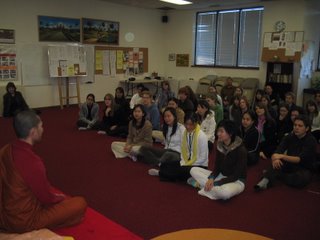to a Volunteer Group of Glenbow Museum
in the Asian Gallery
who visited the centre in May 28, 2005
Cambodian-Canadian Community in Calgary
History and Resettlement
The influence of Vietnamese War had pushed Cambodia into decades of
interior war. During 1975-1979, Cambodia was controlled by the genocidal regime
called Khmer Rouge and there were about two millions of innocent people were
died by the punishment, starvation, over hard work and sickness.
After the Khmer Rouge was overthrown by Vietnamese invasion in January
7, 1979; there were many people were rescued in the refugee camps along the
border line with Thailand. Those suffered people are supported and helped by the
United Nation. And most of them were welcomed to resettle in the new, hoped
land such as USA, Canada, Australia, French, New Zealand, Swiss, etc.
It is the awareness of Cambodian people in everywhere to love their own
way of lives, identity, culture, heritage, language and religion. Anywhere that has
Cambodian people live more than ten families; they shall create their own
community and afford to construct the Temple to centre their identities.
As well as in Calgary when a few Cambodians had arrived before the war and there were a lot Cambodians had arrived after the war. They have resettled almost everywhere throughout Alberta province such as in Edmonton, Calgary, Brooks, Red Deer, Medicine Hat and Let Bridge etc.
Firstly, Cambodian-Canadian Association was created in the year 1980 and
purchased a home to use for monk residence in 1989. Our present Temple was
purchased and renovated in June 22, 2001.
Our Khmer-Canadian Buddhist Cultural Centre here is very useful and
accessible to all people to come and do research independently. As a Non-Profit
Organization, we aim to have our Khmer people enrich the multi-cultural society
of Canada with a sense of peaceful pride.
We give a particular focus to our young, teaching them ethics and self-reliance.
We do this through our Buddhist School, Khmer language classes, insight
meditation, access to internet-computer resources and other youth services and
programs.
Other activities taking place in our Centre are religious ceremonies,
spiritual guidance, ethical observation, bhavana meditation and dana offering.
Cambodian History and Culture
Cambodia is like most of other Asian counties were influenced by the Indian
culture. It was Buddhism and Hinduism which played the important role in
developing and integrating Cambodia into a civilized country. Cambodian ancient
scholars had gradually khmerized those influences into unique Khmer. It has a
long journey combining with the glory and collapsing.
Starting her ancient state that was called Funan(AD.100-600),
Chenla(AD.600-800) and Angkorian Empire(AD.802-1431), Khmer has variously contributed her talent and evolution. During Angkorian Empire, Cambodia was expanded her territory widely from the China Sea to the Gulf of Bengal in the west.
Masterminding in Castles Construction
It is common for each Cambodian king who they ascended to the throne,
they have to build castles or temples to identify his/her glory and to leave as the
legacy for their young generations. Starting from the Funan era till the Post-
Angkorian, the researchers and historians have said that there are more than 1,000
castles was erected throughout Cambodia, Thailand, Laos and Vietnamese.
Angkor Wat known as the largest monument for human kind. It was
built by King Suriyavarman II(AD.1113-1150). It is very beautiful and
incomparable by its size, bas-relief, sculptures and decoration. In the 14th of
December1992, the UNESCO World Heritage Committees declared the
monument, and the whole city of Angkor, a World Heritage Site.
One of these temples- a rival to that of Solomon, and erected by some
ancient Michael Angelo - might take an honorable place beside our most beautiful
buildings. It is grander than anything left to us by Greece or Rome, and presents a
sad contrast to the state of barbarism in which the nation is now plunged (By
Henry Mouhot, a French naturalist who visited Angkor in the year of 1858 - 60).
To Khmer People, Angkor Wat is more than just an ancient pile of stones, it
is more than just the remains of a highly advanced kingdom, it is more than just a
tourist attraction - to the Khmers it is a symbol of hope.
Angkor Thom or Bayon has the Compassionate Smiles(Bayon Smile) to every one, every corners and all creatures to symbolize the greatness of Cambodian greatest final King; Emperor
Jayavarman VII (AD.1181-1215).
Art Styles
The best of this (Angkor) art combines a sensuous sweetness with luxuriant
magnificence, blending joy with delight with intense intellectual and imaginative
strength!. No film, no photograph, nothing can prepare one for Angkor and its
impact. It is even difficult to speak of it in other than superlative terms. For it is
colossal, enormous, prodigious, startling, awesome...., (By Philip Rawson.),
Language
Khmer language or Cambodian is one of the main Austroasiatic languages,
and has had considerable influenced from Sanskrit, Pali. Some of these influences,
such as Sanskrit and Pali, come from the influence of Buddhism and Hinduism on
Khmer culture; the latter two are the result of linguistic contact and geographic
proximity.
The Cambodian language is somewhat unusual among its neighboring countries'
languages of Thai, Laotian and Vietnamese in that it is not a tonal language.
Dialects are sometimes quite marked; notable variations are found in speakers
from Phnom Penh (the capital city) and Battambong.
(This analysis comes from my observation as a conversant speaker of Cambodian
without any background in linguistics).
A notable characteristic of the Phnom Penh accent is a tendency toward
slang and laziness in pronunciation, much like American urban slang. For
instance, "Phnom Penh" will sometimes be shortened to "m'Penh". Another
characteristic of the Phnom Penh accent is observed in words with an "r" sub
consonant in the first syllable (that is, where r is the second consonant, as in the
English word "bread"). The r is not pronounced, the first consonant is pronounced
harder than usual, and the syllable is spoken with a dipping tone much like the
"hoi" tone in the Vietnamese language. For example, I have heard the word "dre"
(meaning "fish") pronounced "te"; the "d" becomes a "t", and the vowel (long A)
begins low and rises in tone.
Written Cambodian is alphabetic like English (and unlike Chinese). Its
alphabet consists of two separate categories -- consonants and vowels.
Pronunciation is given here in the traditional form (you will need a computer with
Khmer fonts to see the letters below). It is also notable that the Cambodian script
has fewer vowel symbols than the language has vowel phonemes. Instead, each
consonant symbol has two digraphs, each with its own inherent vowel
(incidentally making Khmer script an abugida rather than a true alphabet. The
actual vowel sound represented is therefore indicated by the combination of the
vowel symbol plus the inherent vowel of its associated consonant.
Way of life
By the influences of Buddhism, Cambodian people are full of kindness and
hospitality to all visitors. They are quiet, gentle and polite. They are easy to welcome every visitor with a unique smile.
There are many occasions that they always reunite together such as:
religious ceremonies like Bon Choul Chnam(New Year), Bon Pachum Ben(Feast
Festival for Ancestors), Bon Visakha Day(Birth, Enlightenment and Parinibbana of
Lord Buddha), Bon Magha Bochea(Caturonghasanipattha, the birth of Sangha community and the announcement of the codes of recluses), Bon Kathin(Saffron robe offering ceremony), Bon Kan Ben(almsfood offering practice), Bon Choul Vassa(Buddhist Lent or Rain Retreat) and Bon
Cheng Vassa(Buddhist out of Lent)…etc. These religious ceremonies are also
regarded as the Traditional Ceremonies.
Buddhism: General Perspectives
INTRODUCTION
The name Buddhism comes from the word 'budhi' which means 'to wake up' and
thus Buddhism is the philosophy of awakening. This philosophy has its origins in
the experience of the man Siddhartha Gotama, known as the Buddha, who was
himself awakened at the age of 35. Buddhism is now 2,548 years old and has
about 400 million followers worldwide. Until a hundred years ago Buddhism was
mainly an Asian philosophy but increasingly it is gaining adherents in Europe,
Australia and America.
BUDDHA
Who was the Buddha?
Before he became a Buddha, Siddhartha was a prince. But he wasn't just any old
prince, his mother had prophetic dreams before he was born and wise men made
great predictions about his destiny.
Leaving the Palace
During an excursion outside the palace walls, Prince Siddhartha was so deeply
affected when he saw a sick man, an old man and a corpse, he decided to leave the
palace and become a monk.
Under the Bodhi Tree
Nibbana or Enlightenment is the goal of all Buddhists. This means putting an end
to the suffering we experience in life. The Buddha endured six years of physical
hardship as a monk before he attained Enlightenment whilst meditating under the
Bodhi tree.
What the Buddha Taught
The most important Buddhist Teaching is the Four Noble Truths. This explains
why we suffer and what we can do to eliminate suffering from our life. After the
Buddha attained Enlightenment, this was his first Teaching. His first lucky
students were five monks he knew.
The Buddha's Disciples
Sangha - the Buddha's male and female disciples, during his lifetime and right up
to the present day. Although Sangha traditionally refers to monks and nuns, these
days it also refers to lay followers of Buddhism.
Loving-Kindness
The Buddha taught that positive qualities such as loving-kindness should replace
negative ones such as selfishness. One way of doing this is through meditation.
Without developing a good heart, it's impossible to achieve lasting happiness.
The Buddha's Last Days
The Buddha on the last stage of his journey. Even great teachers must die, and the
Buddha was no exception. However, his death was by no means the end of the
story. Today his Teachings are still very much alive.
Who is a Buddhist?
This unit defines a Buddhist as one who takes refuge in the Triple Gem (the
Buddha, Dhamma and Sangha), and willingly follows the Five Precepts. These are
rules for living a moral life, and include not killing, stealing and lying.
Four Noble Truth
1. The truth of suffering such as birth, aged, sick, death, sorrow, lamentation,
physical pain, grief, despair, association with hateful ones, separation from
loved one, not getting what one wants and the five groups of
grasping(clinging).
2. The truths of the cause of sufferings are defilements, ignorance and craving
or greed, hatred and delusion.
3. The truth of the cessation of sufferings is Enlightenment or Nibbana.
4. The truth of the ways leading to the cessation of sufferings: Eightfold Path.
Five Precepts
I undertake to:
1. Abstain from killing living beings;
2. Abstain from taking that which not given;
3. Abstain from sexual misconduct;
4. Abstain from false speech;
5. Abstain from distilled substances that confuse the mind. (Alcohol and Drugs)
The Five Precepts in positive terms
I undertake the training precept to:
1. Act with Loving-kindness;
2. Be open hearted and generous;
3. Practice stillness, simplicity and contentment;
4. Speak with truth, clarity and peace;
5. Live with mindfulness.
The Three Signs of Existence or Universal Properties
1. Anicca — Impermanent;
2. Dukkha — Unsatisfactory, stress inducing;
3. Anatta — Insubstantial or Not-self.
The Four Sublime or Uplifted States
1. Metta — Friendliness, Loving- kindness;
2. Karuna — Compassion;
3. Mudita — Joy, Gladness. Appreciation of good qualities in people;
4. Upekkha — Equanimity, the peaceful unshaken mind.
The Eight Fold-Path
Right, Integral, Complete, Perfected...
1. Right View, Understanding;
2. Right Attitude, Thought or Emotion;
3. Right Speech;
4. Right Action;
5. Right livelihood;
6. Right Effort, Energy, and Vitality;
7. Right Mindfulness or Awareness;
8. Right Samadhi "concentration", one-pointedness. Integration of, or establishment in, various levels of consciousness.
Creation of Sangha(monk) community
A few months after his enlightenment the Buddha founded an order or Sangha of
monks. The purpose of this order was twofold. Its primary purpose was to provide
a community that would give the optimum opportunity for its members to practice
the Dhamma and attain Nibbana. Its secondary purpose was to transmit the
Dhamma and be a witness to its transforming power.
Becoming a Monk
• To become a novice (samanera) all that is needed is to approach a monk of
at least 10 years standing and ask to be accepted. After undertaking several
years training and being at least 20 years old the novice is qualified to be a
fully ordained monk. To do this he must approach an assembly of 10 monks
each of at least 10 years standing who are respected for their virtue and
learning. The candidate is then asked 11 questions to determine his
suitability. (1) Are you free from disease? (2) Are you a human? (3) Are
you a male? (4) Are you a free man? (5) Are you free from debt? (6) Do
you have any obligations to the state? (7) Do you have your parent’s
permission? (8) Are you at least 20 years of age (9) Do you have your robe
and towel? (10) What is your name? (11) What is your teacher’s name? If
the candidate answers these questions satisfactorily and if no objections are
raised by the assembly, he is considered to be a fully ordained monk
(Bhikku). A monk can use property belonging jointly to the sangha but he
himself is supposed to own only eight things - three robes, an alms bowl, a
razor, needle and thread, belt, and a strainer to purify drinking water. He is
also obliged to abide by the 227 rules contained in the Vinaya Pitaka.
Meditation
• There are two kinds of meditation: Concentration Meditation (Samatha)
and Insight Meditation (Vipassana)
1. Concentration Meditation means you control your mind to be a pointedness
mind.
2. Insight Meditation means you are aware or noting every movement of
thought.
Seven Benefits of Mindfulness Meditation
1. Purification: this mindfulness meditation must be practiced for purification
of beings. This is the first benefit. If you are mindful of any mental or
physical process, if your concentration is good enough, at the moment of
deep concentration on this mental or physical process your mind is purified.
It's free from all kinds of mental defilements, all kinds of hindrances.
2. Overcoming sorrow: then the second benefit is overcoming worry, sorrow
and lamentation. The second benefit is sorrow and worry. You overcome
sorrow and worry even though you failed in your business. You don't worry
about it; you don't feel sorry.
3. Overcoming lamentation: When you have completely realized the mental
and physical processes and their true nature by means of mindfulness
meditation, even though your relative dies, or even though your sons or
parents die you won't cry over it. You have exterminated this lamentation
for the dead.
4. Overcoming grief: Then, the fourth benefit is the overcoming of grief. In the
full retreat you can do away with grief, when your mindfulness meditation is fully
practiced. Here grief means mental suffering. Mental suffering is exterminated,
done away with, by this mindfulness meditation.
5. Overcoming physical suffering: And also pain here means physical suffering.
All kinds of physical suffering are destroyed through mindfulness meditation.
There are some who cured illness by means of mindfulness meditation. The fifth
benefit is overcoming physical suffering, dukkha. Mental suffering is known as
domanassa in Pali. Physical suffering is known as dukkha. Domanassa is mental
suffering, mental dukkha. Physical suffering is dukkha itself. These two aspects of
suffering are removed by means of mindfulness meditation.
6. Enlightenment: Then the sixth benefit is attainment of path knowledge. That's
one of enlightenment. In Buddhism there are four stages of enlightenment a
meditator has to attain through his mindfulness meditation, after he has completed
all thirteen stages of insight knowledge
. The first stage is known as sotapannamagga
. The second stage is known as sakadagami-magga
. Third stage is known anagami-magga
. The fourth stage is known as arahatta-magga.
All these four stages of enlightenment can be attained when you have thoroughly realized
anicca, dukkha and anatta of bodily and mental processes. When impermanence,
suffering, the impersonal nature of body-mind processes are thoroughly realized
then you can attain all these four stages of enlightenment.
7. Nibbana:Then finally you attain to Nibbana by mindfulness meditation. What
do you mean by Nibbana? Where do you see Nibbana, on earth or underground or
in heaven or in the sky? Ah, but the Buddha said Nibbana is in you. The place
where you attain to Nibbana is yours, your body and mind. Unless you have
realized your body-mind processes you cannot attain Nibbana. Only when you
have fully realized your body-mind processes and two levels of understanding,
then you are sure to attain Nibbana. So Nibbana is with you, not very far, very
close.


















